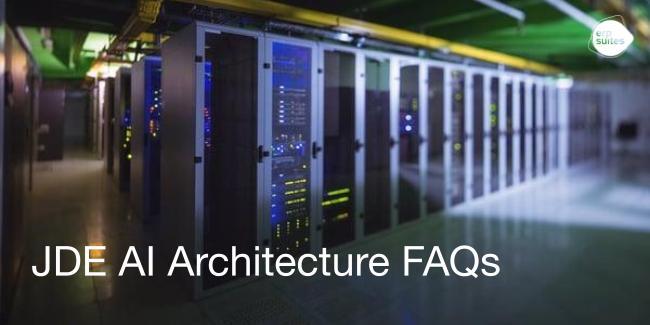Should You Delay Your JD Edwards Continuous Adoption Initiative?
January 17th, 2025
5 min read
.png?width=650&height=325&name=Blog%20Images%202_1%20(1).png)
You know regular updates and upgrades for your company’s ERP system are important. But maybe you’ve skipped a few here and there. After all, they can require time, continuity, and capacity.
If you let your updates stack up for too long, though, there will be a critical feature your team can’t access – or worse, you could find yourself falling behind your competitors.
Here at ERP Suites, we understand where you’re coming from. That’s why when we help customers upgrade their JD Edwards, we keep them in the loop every step of the way. We explain the benefits a continuous adoption model can have for your business. We want to help you and your business succeed now and in the future with the most up-to-date version of JDE you can have.
In this article, we’ll break down the biggest challenges when you postpone JDE upgrades and how continuous adoption can help you avoid these pitfalls.
What is Continuous Adoption in JD Edwards?
Continuous adoption is the practice of regularly taking JDE updates and upgrades. This is more than just having the latest version. It means you’re actively implementing and leveraging new features.
Oracle, JDE’s parent company, releases updates quarterly. These provide incremental improvements to the system. Updates can range from security patches to brand-new features, like enhanced inventory management tools or personalized user interfaces.
The key distinction? Adoption. A.k.a., actually using these features and new and improved capabilities. Simply installing updates is only half the battle. You need to actually use them to get their promised value. Think of it like a phone update. Downloading the new version is one thing. But exploring and activating a new feature like enhanced security settings is another.
What Are the Biggest Problems with Delaying JD Edwards Upgrades?
You might choose to delay your JD Edwards upgrades for any number of reasons. Upgrades and updates can take time, can cause business disruptions, and can require dedicated team members. But the risks can often outweigh these short-term benefits.
If you delay upgrades, you face:
- Increased costs and efforts over time
- Falling behind in innovation
- Security vulnerabilities and compatibility issues
- User frustration
Delaying JD Edwards Upgrades Increases Costs and Effort Over Time
Skipping updates might feel like you’re saving time and money, but it’s a short-term gain with long-term pain. Each skipped update adds to a growing technical debt. Eventually, catching up becomes a monumental task requiring a complete overhaul.
For example, let’s say a company running JD Edwards 9.1 is interested in automating some of their warehouse processes. They want to adopt tools like orchestrations to get the job done. But 9.1 was released over a decade ago. They’re facing major hurdles because the Orchestrator Studio is only available on 9.2 releases and later.
Now, they have to spend even more time and money to correct their out-of-date system all at once. If they had at least kept up with incremental changes and releases, never mind making the changeover to 9.2 when it became available, this wouldn’t be a problem. They would have spread out the time, money, and labor involved in upgrading their JD Edwards instead of dealing with it all at once.
How Does Continuous Adoption Lower Total Cost of Ownership?
Continuous adoption spreads upgrade costs over time. Plus, adopting efficiency-boosting features (like enterprise process automation) can reduce operational expenses. This can lead to significant ROI.
Delaying JD Edwards Upgrades Risks Falling Behind in Innovation
The JD Edwards application layer and the JD Edwards technology stack (which includes tools like orchestrations, noted above) both receives regular updates. Without these releases, you can’t use the tools above. But another downside is the inability to keep up with your competitors.
If your competitors practice continuous adoption and you don’t, you won’t be able to offer your customers cutting-edge services and quality.
For instance, a recent JDE update introduced advanced safety stock management. It allows businesses to reserve inventory for critical orders.
Without adopting this feature, companies may struggle to meet demand efficiently, especially during supply chain disruptions. If your customers become disenchanted by your lackluster performance, they might start seeking out greener pastures. Maintaining a competitive edge is more important than ever in today’s hundred-miles-an-hour marketplace.
How Does Continuous Adoption Reduce Risk?
By staying current, updates are smaller, less disruptive, and easier to manage. Businesses can implement new features incrementally, avoiding the chaos of a massive overhaul every few years.
Delaying JD Edwards Upgrades Exposes Your Business to Compatibility Issues and Security Risks
JDE tools and applications evolve together. Skipping updates creates compatibility gaps. We’ve explained above how a business on an older release can’t reach the features on newer releases. For some of these tools, customers need to upgrade their tools and application layers together.
Take security, for example. Delaying updates leaves your JD Edwards system exposed to security risks. The thing is, security crosses both applications and tools layers. Security is utilized and implemented in JDE applications, but the functionality, the code that makes it work, is located in the tools layer.
Let’s say a company goes off support from Oracle, meaning they no longer pay for maintenance contracts for their software from Oracle itself. Meanwhile, the latest release package from Oracle contains a patch for a security vulnerability that exists on older releases. If that customer operates on the older release, they can’t access the security patch. This opens up a big security vulnerability and leaves them open to getting hacked.
How Does Continuous Adoption Improve System and Security Performance?
Frequent updates allow JDE developers to refine processes, improving speed and reliability. For example, recent updates have optimized sales order processing, cutting down on manual entry and errors.
Delaying JD Edwards Upgrades Leads to User Frustration and Inefficiency
As systems age, they become harder to navigate. Modern updates often include user-friendly enhancements like personalization options. These allow users to customize their interfaces. By tailoring the system to their specific needs, they can work more quickly and efficiently.
High levels of user-centricity can lead to higher adoption rates and increased satisfaction. Employees feel their voices are being heard. Their productivity is being prioritized, and they can see it happening.
Without these kinds of qualitative changes, employees feel stuck. Not to mention, they end up wasting time dealing with outdated interfaces. This leads to frustration and decreased productivity.
How Does Continuous Adoption Enhance User Experience?
Continuous updates introduce features like personalized forms, allowing users to hide irrelevant fields and customize layouts. This boosts efficiency and satisfaction, helping employees work smarter, not harder.
What Are the Challenges with Implementing Continuous Adoption?
Of course, adopting updates regularly isn’t without its hurdles.
- Time and Resources: Testing and configuring new features takes effort, even for minor updates.
- Cultural Resistance: Teams accustomed to the status quo may resist change.
- Customizations: Older customizations may need retrofitting to align with new updates.
To get the most out of your updates when you apply continuous adoption, it’s important to plan them strategically. Schedule updates during slower periods to minimize disruption.
Take time to engage with your stakeholders. Communicate the benefits to gain buy-in from leadership and end users. Are there players on your team who hold influence over their peers? Make sure they’re bought in.
Don’t be afraid to bring in expert support. Take advantage of the expertise consulting and advisory teams (like ERP Suites) bring to the table. They can apply their knowledge to your continuous adoption strategy and help you streamline the process.
And finally, don’t attempt to do everything all at once. Adopt incrementally. If you’re mostly up to date, focus on a few high-impact features each update cycle. If you need a more drastic overhaul, consider whether to bundle your upgrades into a larger company transformation.
Making the Case for Continuous Adoption of JD Edwards Updates and Upgrades
Delaying updates might seem like the easier path, but it’s a risk that can lead to higher costs, security issues, and lost opportunities. Continuous adoption, on the other hand, keeps your business competitive, secure, and efficient.
You’re not just maintaining your ERP—you’re positioning your company for success.
Ready to explore how continuous adoption can work for your business? Check out these firsthand tips from our advisory team experts.
Leyla Shokoohe is an award-winning journalist with over a decade of experience, specializing in workplace and journalistic storytelling and marketing. As content manager at ERP Suites, she writes articles that help customers understand every step of their individual ERP journey.
Topics:



.png?width=650&height=325&name=Blog%20Images%202_1%20(4).png)
.png?width=650&height=325&name=Blog%20Images%202_1%20(5).png)
.png?width=650&height=325&name=Blog%20Images%202_1%20(3).png)
.png?width=650&height=325&name=Blog%20Images%202_1%20(2).png)
.png?width=960&height=540&name=Blog%20Images%20(96).png)

.png?width=960&height=540&name=Blog%20Images%20(90).png)
.png?width=960&height=540&name=Blog%20Images%20(88).png)
.png?width=960&height=540&name=Blog%20Images%20(87).png)
.png?width=960&height=540&name=Blog%20Images%20(86).png)
.png?width=960&height=540&name=Blog%20Images%20(85).png)
.png?width=960&height=540&name=Blog%20Images%20(83).png)
.png?width=960&height=540&name=Blog%20Images%20(82).png)
.png?width=960&height=540&name=Blog%20Images%20(80).png)
.png?width=960&height=540&name=Blog%20Images%20(79).png)
.png?width=960&height=540&name=Blog%20Images%20(78).png)